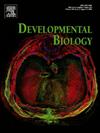Quantitative proteomics of regenerating and non-regenerating spinal cords in Xenopus
IF 2.5
3区 生物学
Q2 DEVELOPMENTAL BIOLOGY
引用次数: 0
Abstract
Spinal cord injury in humans is a life-changing condition with no effective treatment. However, many non-mammalian vertebrates can fully regenerate their spinal cord after injury. Frogs such as Xenopus can regenerate the spinal cord at larval stages, but lose this capacity at metamorphosis. This makes them ideal models to elucidate molecular pathways underlying regenerative capacity by comparing responses to spinal cord injury in regenerative (R) and non-regenerative (NR) stages of the same species. Here we use quantitative proteomics with Isobaric Tags for Relative and Absolute Quantification (iTRAQ) followed by Ingenuity Pathway Analysis (IPA) to identify functions and pathways that were differentially regulated after spinal cord injury between R and NR stages in Xenopus laevis. We find that many embryonic pathways of neuronal development are re-activated following SCI at the R but not at the NR stage. This is accompanied by the upregulation of regulatory proteins controlling transcription and translation at the R stage, but their downregulation at the NR stage. Conversely, lipid hydrolysis and uptake as well as mitochondrial oxidative phosphorylation is downregulated at the R, but upregulated at the NR stage. Taken together this suggests that dysregulation of lipid homeostasis and augmentation of oxidative stress play a key role in the loss of regenerative capacity of the spinal cord after metamorphosis. In identifying new factors regulating regenerative capacity in the vertebrate spinal cord, our findings suggest new potential therapeutic targets for promoting neural repair in the injured adult mammalian spinal cord.

非洲爪蟾再生和非再生脊髓的定量蛋白质组学研究。
人类脊髓损伤是一种改变生命的疾病,没有有效的治疗方法。然而,许多非哺乳动物的脊椎动物在脊髓损伤后可以完全再生。像非洲爪蟾这样的青蛙在幼虫阶段可以再生脊髓,但在变态阶段就失去了这种能力。这使得它们成为理想的模型,通过比较同一物种在再生(R)和非再生(NR)阶段对脊髓损伤的反应来阐明再生能力的分子途径。在这里,我们使用定量蛋白质组学和等压标签相对和绝对定量(iTRAQ)以及独创性途径分析(IPA)来确定非洲爪蟾脊髓损伤后R和NR阶段的功能和途径差异。我们发现许多神经元发育的胚胎通路在脊髓损伤后的R期而不是NR期被重新激活。这伴随着调控蛋白在R期调控转录和翻译的上调,但在NR期调控蛋白下调。相反,脂质水解和摄取以及线粒体氧化磷酸化在R期下调,但在NR期上调。综上所述,这表明脂质稳态失调和氧化应激增强在变态后脊髓再生能力丧失中起关键作用。通过发现调节脊椎动物脊髓再生能力的新因素,我们的发现为促进成年哺乳动物脊髓损伤的神经修复提供了新的潜在治疗靶点。
本文章由计算机程序翻译,如有差异,请以英文原文为准。
求助全文
约1分钟内获得全文
求助全文
来源期刊

Developmental biology
生物-发育生物学
CiteScore
5.30
自引率
3.70%
发文量
182
审稿时长
1.5 months
期刊介绍:
Developmental Biology (DB) publishes original research on mechanisms of development, differentiation, and growth in animals and plants at the molecular, cellular, genetic and evolutionary levels. Areas of particular emphasis include transcriptional control mechanisms, embryonic patterning, cell-cell interactions, growth factors and signal transduction, and regulatory hierarchies in developing plants and animals.
 求助内容:
求助内容: 应助结果提醒方式:
应助结果提醒方式:


